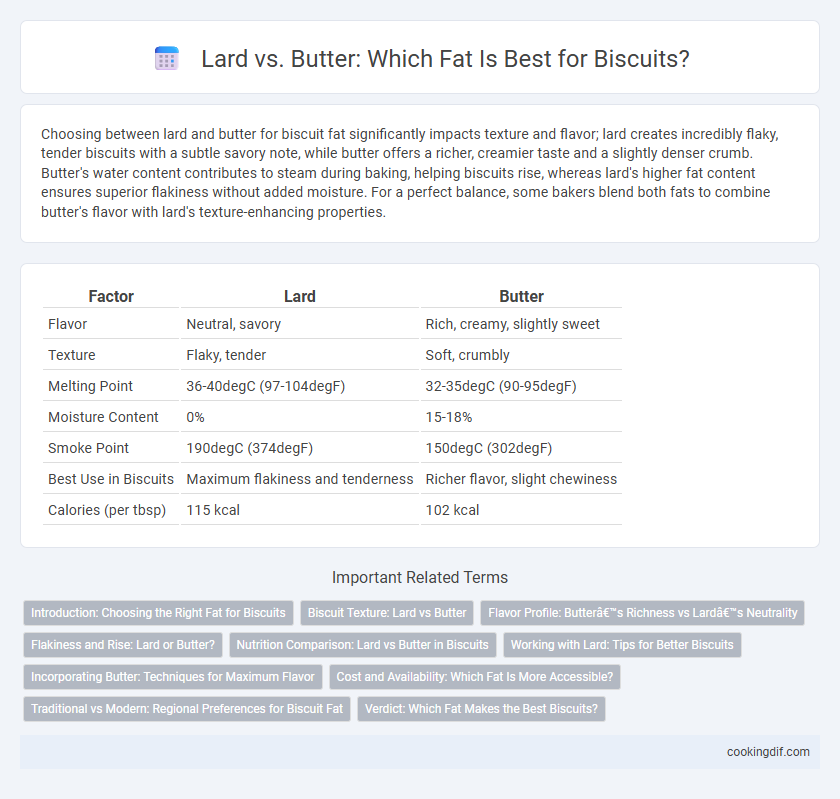Choosing between lard and butter for biscuit fat significantly impacts texture and flavor; lard creates incredibly flaky, tender biscuits with a subtle savory note, while butter offers a richer, creamier taste and a slightly denser crumb. Butter's water content contributes to steam during baking, helping biscuits rise, whereas lard's higher fat content ensures superior flakiness without added moisture. For a perfect balance, some bakers blend both fats to combine butter's flavor with lard's texture-enhancing properties.
Table of Comparison
| Factor | Lard | Butter |
|---|---|---|
| Flavor | Neutral, savory | Rich, creamy, slightly sweet |
| Texture | Flaky, tender | Soft, crumbly |
| Melting Point | 36-40degC (97-104degF) | 32-35degC (90-95degF) |
| Moisture Content | 0% | 15-18% |
| Smoke Point | 190degC (374degF) | 150degC (302degF) |
| Best Use in Biscuits | Maximum flakiness and tenderness | Richer flavor, slight chewiness |
| Calories (per tbsp) | 115 kcal | 102 kcal |
Introduction: Choosing the Right Fat for Biscuits
Lard and butter both play crucial roles in biscuit texture and flavor, with lard yielding flakier, tender biscuits due to its higher melting point and minimal water content. Butter, prized for its rich, creamy taste, contributes a slightly denser texture and golden color from milk solids during baking. Selecting the right fat depends on the desired balance between flakiness and flavor intensity in biscuit recipes.
Biscuit Texture: Lard vs Butter
Lard produces biscuits with a flaky, tender texture due to its larger fat crystals and higher melting point, which create distinct layers during baking. Butter contributes a richer flavor and a slightly denser, crumbly texture because of its water content and lower melting point. Choosing lard over butter results in biscuits that rise higher and have a lighter, airier crumb, preferred for classic Southern-style biscuits.
Flavor Profile: Butter’s Richness vs Lard’s Neutrality
Butter imparts a rich, creamy flavor that enhances the biscuit's taste with subtle dairy notes, creating a more complex and indulgent profile. Lard offers a neutral flavor that allows other ingredients to shine, resulting in a tender texture without overpowering the biscuit's natural taste. Choosing butter versus lard influences the final biscuit flavor, balancing richness against a mild, unobtrusive fat presence.
Flakiness and Rise: Lard or Butter?
Lard produces a flakier texture and higher rise in biscuits due to its larger fat crystals that create distinct layers during baking. Butter contributes rich flavor and browning but tends to yield a denser, less flaky biscuit compared to lard. For optimal flakiness and lift, bakers often prefer lard or a combination of lard and butter.
Nutrition Comparison: Lard vs Butter in Biscuits
Lard contains more monounsaturated fats and lacks trans fats, offering a lower saturated fat content compared to butter, which is rich in saturated fats and cholesterol. Butter provides valuable vitamins A and D but has higher calories per serving, potentially impacting heart health when consumed excessively. Choosing between lard and butter for biscuits hinges on balancing flavor preferences with nutritional benefits such as fat quality and vitamin content.
Working with Lard: Tips for Better Biscuits
Working with lard for biscuits enhances flakiness due to its higher fat content and lower melting point compared to butter. To achieve optimal texture, keep lard cold and use a pastry cutter or your fingers to incorporate it quickly into the flour, creating small, pea-sized pieces. Avoid overmixing to maintain tender layers and ensure biscuits rise evenly with a light, airy crumb.
Incorporating Butter: Techniques for Maximum Flavor
Incorporating butter into biscuit dough requires keeping it cold and cutting it into small, even pieces to create flaky layers and rich flavor. Unlike lard, butter adds a creamy, slightly sweet taste that enhances the overall biscuit experience, while its higher water content helps steam pockets for lift. Techniques such as folding and minimal handling preserve the butter's integrity, ensuring a tender texture and maximum flavor release during baking.
Cost and Availability: Which Fat Is More Accessible?
Lard is generally more affordable and widely available in many regions, especially in traditional markets, making it a cost-effective option for biscuit fat. Butter, while often pricier due to dairy production and seasonal variations, is more accessible in supermarkets and specialty stores, providing consistent quality. The choice between lard and butter for biscuits depends largely on local availability and budget considerations, with lard offering economic advantages and butter providing a familiar, rich flavor.
Traditional vs Modern: Regional Preferences for Biscuit Fat
Traditional Southern biscuits often rely on lard for its superior flakiness and rich flavor, reflecting regional preferences rooted in historical cooking practices. Modern recipes increasingly favor butter to achieve a slightly sweeter taste and softer texture, appealing to contemporary palates. The choice between lard and butter significantly influences biscuit texture and flavor, underscoring distinct culinary identities in various regions.
Verdict: Which Fat Makes the Best Biscuits?
Butter provides a rich flavor and a slightly denser texture in biscuits, while lard creates a flakier, tender crumb due to its higher fat content and unique melting properties. The best biscuits often depend on personal preference, but many bakers favor lard for its superior flakiness and moisture retention. Combining butter and lard can yield biscuits with both buttery taste and optimal texture.
Lard vs butter for biscuit fat Infographic

 cookingdif.com
cookingdif.com